Your Complete Guide to Creating a Sustainable Pond
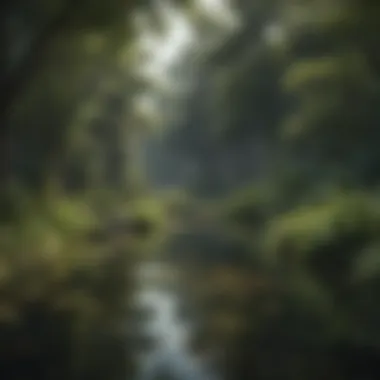
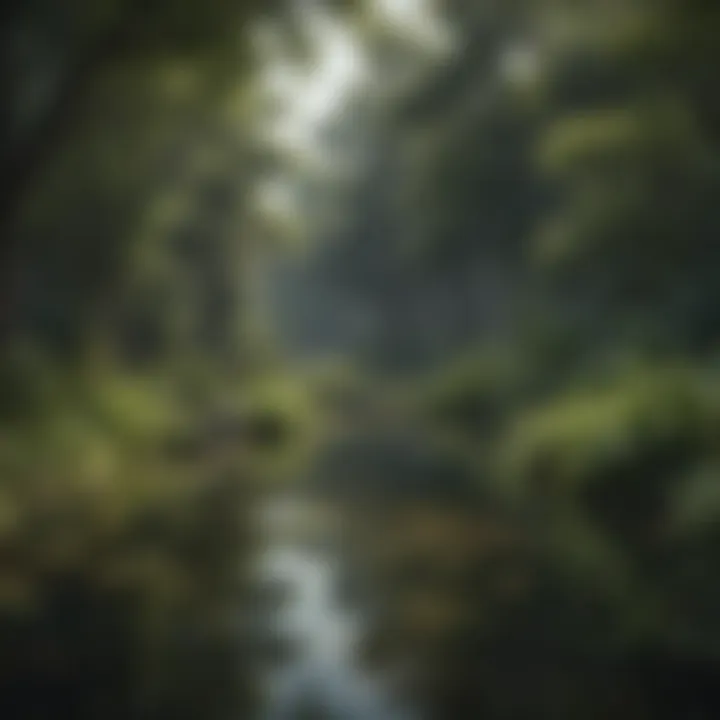
Overview of the Topic
Creating a pond is not just a hobby. It’s about embracing and enhancing a vital natural resource. Ponds serve as gateways to biodiversity, attracting a variety of species from frogs to dragonflies. They can act as natural filters, improving water quality and providing habitats for countless organisms. Understanding the nuances of establishing a pond is crucial for anyone with a heart for conservation.
For centuries, humans have formed bonds with water bodies. From traditional rice paddy systems to contemporary garden ponds, the relationship is deep-rooted. The importance of ponds goes beyond aesthetics; they also play a critical role in local ecosystem health. Engaging with these natural landscapes opens up discussions surrounding resource management and sustainability.
Current Status and Challenges
In recent years, the landscapes where ponds might flourish have faced numerous challenges. Urban development, pollution, and climate change demonstrate just how delicate these ecosystems can be. Many ponds have been lost or degraded, and water quality has declined significantly, leading to a cascade of ecological consequences.
As communities grow, pressure mounts on local water systems. Some of the pressing challenges include:
- Pollution: Runoff from agricultural practices and urban areas can introduce harmful substances into the water, hindering aquatic life.
- Invasive Species: Non-native plants and animals often outcompete local species, disrupting the natural equilibrium.
- Climate Change: Temperature shifts and altered precipitation patterns can substantially affect pond ecosystems, potentially harming species adapted to specific conditions.
These challenges make it imperative for pond enthusiasts to think critically about their projects and approach.
Sustainable Solutions
To counter these issues, there is a rising movement among conservationists towards sustainable pond management. Numerous practices focus on restoring and preserving pond ecosystems:
- Natural Filtration: Using native plants to absorb excess nutrients helps improve water quality.
- Habitat Diversity: Designing a pond with varying depths and plants can support multiple species and contribute to biodiversity.
- Community Engagement: Involving local communities in monitoring and maintaining ponds can foster stewardship and sustainability.
Successful examples of pond restoration projects can often be found in local conservation organizations. For instance, a community initiative in New York demonstrated how diversifying plant life improved water clarity and habitat for local amphibians.
Impact and Importance
Ponds act like the glue that holds various ecosystems together. They provide not only shelter but also breeding grounds for wildlife. Their presence can significantly influence local geography and climate, creating microhabitats that nurture life. Thus, the importance of ponds extends far beyond their immediate environment.
The act of nurturing these ecosystems has lasting consequences. Conserving natural resources today means preserving options for future generations. Every successful pond established contributes to a legacy of environmental stewardship. It’s about creating spaces that will last, fostering a love of nature in those who come after.
"Conservation is a state of harmony between men and land." – Aldo Leopold
The need for conservation efforts cannot be overstated, particularly in engaging youth and educating them about the importance of aquatic ecosystems. The intergenerational knowledge transfer will undoubtedly strengthen the community’s bond with its natural resources.
For more information on ecosystems and conservation, you can visit Wikipedia or read more about the importance of biodiversity at Britannica.
Head to Facebook or Reddit for community discussions and shared experiences.
Understanding the Purpose of a Pond
Understanding the purpose of a pond is crucial before you leap into constructing one. It’s like preparing a recipe where each ingredient has a role, and the end dish reflects the care and consideration put into each step. A pond can serve multiple purposes—it can be a haven for wildlife, a recreational space, or even a method for water management. Each of these purposes comes with unique benefits and considerations, making it essential to clarify what you want before you embark on this journey.
Recreational Uses and Benefits
Many ponds offer opportunities for recreation. Think of a serene area where you can fish, kayak, or simply unwind by the water’s edge. These activities not only provide enjoyment but also promote a connection with nature. Furthermore, having a pond can greatly increase property value. People are often drawn to homes with water features, associating them with tranquility and beauty.
"Ponds transform a simple landscape into a destination. They breathe life into the ground around them, providing space for leisure and joy."
Also, consider that different activities can attract various groups. Family outings, educational school trips, or peaceful solo retreats each reveal different facets of pond usage. It's important to think about your community's needs and how your pond can fulfill them, thus enhancing both individual and communal experiences.
Biodiversity Enhancement
A pond can significantly boost local biodiversity. It acts as a sanctuary for various species, including fish, amphibians, birds, and even insects. More than just a water source, a well-planned pond provides habitats and breeding grounds. The presence of aquatic plants can support insects which, in turn, feed birds. It’s a systemic ballet of life that showcases the interconnectedness of ecosystems.
Take the example of a garden pond that’s carefully planted with native water lilies and cattails—the result is often an inviting environment for pollinators and other wildlife. By nurturing these species, not only do you beautify your space, but you also contribute to the ecological health of your area. It's an investment in nature that pays dividends in both aesthetic value and environmental sustainability.
Water Management and Conservation
Lastly, ponds play a vital role in water management and conservation. They can act as natural filters, absorbing excess nutrients and pollutants, thereby improving the surrounding environment. This is especially relevant in zones prone to flooding, where ponds can help regulate water levels effectively. It's like having a sponge right in your backyard, capable of soaking up heavy rains and reducing runoff.
Building a pond necessitates consideration of location and design. Properly managed, it can reduce erosion and even augment groundwater recharge. As water scarcity continues to be an increasing concern, having a well-functioning pond can be a step toward sustainable solutions. It serves as a reminder that even small ecological interventions can lead to larger environmental impacts.
Choosing the Right Location
When it comes to setting up a pond, picking the right location is half the battle won. The site you choose will not only dictate the aesthetic appeal but also the ecological integrity of your future aquatic paradise. A well-placed pond can enhance your landscape and provides numerous benefits for wildlife, while a poorly chosen one may turn into a maintenance headache.
Evaluating Sunlight and Shade
Sunlight plays a pivotal role in the success of your pond. Most aquatic plants, such as lilies and irises, rely on ample sunlight to thrive. Ideally, you want areas of your pond to receive at least six hours of sunlight per day. However, it’s not all about chasing the sun; some shade can be beneficial, too. Too much direct sun can lead to excessive algae growth, suffocating your water's ecosystem.
Think of it this way: just like humans, plants have their preferences. While some enjoy basking in sunlight, others thrive in shadier spots. A smart approach would be to observe how sunlight moves across your chosen area throughout the day. Look for areas that offer both sunny and shaded patches, giving you flexibility in plant selection and overall health of the pond.
Access to Water Sources
Not all ponds start with a river meandering through the backyard. In fact, easy access to natural water sources is often a key factor. Rainfall, groundwater, or nearby lakes can greatly influence the health and stability of your pond. If you can hook up to a natural water source, you’ll be less dependent on municipal water and can allow your pond to maintain its levels naturally with seasonal rains.
You might want to consider the slope of the land, too. A naturally sloping area can help in capturing runoff from storms, which is a bonus not just for water supply, but it can also be a source of nutrients that enhance biodiversity. Meanwhile, a flat area might seem simpler but could lead to challenges like stagnant water.
Soil Compatibility
The soil beneath your future pond is like the foundation of a house—critical for success. And let’s be honest: not all soils play well with water. It’s vital to check your soil’s drainage capabilities and its composition before diving into construction. If the soil drains too quickly, you might have trouble keeping water levels stable, leading to a dried-up pond before you can even enjoy it.
A simple soil test can reveal its type and quality. For instance, if you find a high clay content, rejoice! Clay retains water exceptionally well and can help maintain the depth you're aiming for. On the flip side, sandy soils may require additional consideration, such as liners, to ensure the water doesn’t just slide away.
In summary, choosing the right location is an art and a science. It involves understanding your land and the delicate balance of sunlight, water access, and soil type. If you nail these elements from the outset, your pond will flourish, inviting wildlife and creating a serene retreat that aligns sustainability with aesthetics.
"A pond is not just a body of water; it's a living ecosystem that reflects our understanding of nature's principles."
Careful consideration in this stage sets the stage for the vibrant life your pond can sustain.
Designing Your Pond
Designing a pond isn’t just about digging a hole and filling it with water. It’s rather a thoughtful process that involves blending aesthetics with ecological functionality. This section will explore the intricacies of pond design, highlighting specific elements that carry profound significance for both aquatic life and human enjoyment.
Pond Shape and Size Considerations
The shape and size of your pond play a crucial role in its overall ecosystem and how it serves its intended purpose. When you’re considering the dimensions, visualize how the water body will complement the surrounding landscape.
- Shapes to Consider: Curved designs generally look more natural and can enhance biodiversity by providing varied habitats. On the other hand, geometric shapes might suit more formal gardens, but they can limit the ecological variety.
- Dimensions: A small pond can be beneficial for a residential garden, while a larger one might be necessary for supporting a diverse aquatic habitat. If you’re planning to stock fish or encourage specific wildlife, greater surface area allows more room for ecological interactions.
As a rule of thumb, setting a pond with a depth of at least three feet in some areas encourages better temperature regulation and oxygen levels, which aquatic life thrives on. However, shallow edges promote plant growth and provide habitat for various species.
"A well-designed pond is a living piece of art—a biological masterpiece that reflects both nature and human creativity."
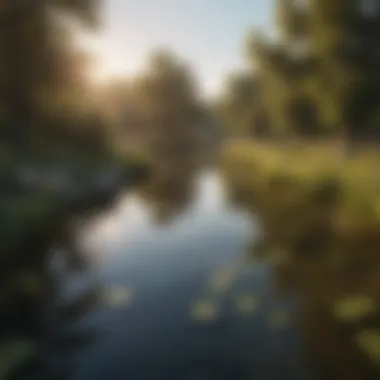
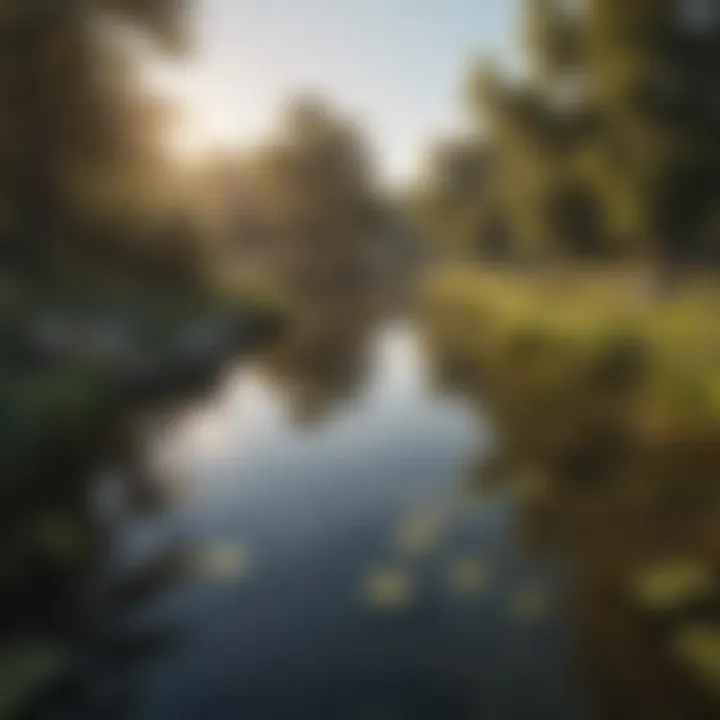
Depth Variation for Ecological Balance
Depth variation is not merely a technical consideration; it’s a vital component in maintaining a balanced ecosystem. Different species of plants and animals prefer varying depths, which can influence the diversity within the pond.
- Shallow Areas: These zones are hot spots for growth. They support a variety of emergent plants that help filter water and provide shelter for fish fry. Shallow waters also warm up more quickly during the season, attracting insects and small creatures that are foundational to the food web.
- Deep Areas: In contrast, deeper sections help in water circulation and keep the pond cooler during warmer months, providing refuge for aquatic creatures during harsh weather. Additionally, deeper areas can serve as sediment traps, preventing excessive nutrient buildup which can lead to issues like algal blooms.
Planning for depth variation ensures your pond isn’t just a stagnant body; it's a vibrant community capable of sustaining life.
Implementing Natural Features
Incorporating natural features into your pond design will create habitats and enhance its appeal. Natural-looking ponds seamlessly blend into their environment and support a greater variety of wildlife.
- Rocks and Logs: These can be strategically placed to provide shelter for fish and frogs, as well as helping to stabilize banks. Using local stones and fallen logs allows the pond to appear as if it belongs in the landscape, rather than being a man-made structure.
- Plant Shelves: Including shelves at various depths lets you plant native aquatic plants, which provide shade and cover. This reduces fluctuations in water temperatures and deters invasive species.
- Natural Slopes: Aim for gently sloped edges rather than steep banks. This design encourages a variety of plant growth and eases wildlife access, whether they’re sipping some water or hunting for aquatic insects.
Incorporating these natural features can transform your pond from a mere water body into a dynamic habitat that fosters not only beauty but biodiversity as well.
Understanding Water Quality
When setting up a pond, understanding water quality isn’t just another box to check off; it's the backbone of a healthy aquatic ecosystem. Water quality ensures that the pond supports the diverse life within it—from the plants, and fish to the microorganisms crucial to maintaining balance. Poor water quality can lead to various issues, including fish die-offs, algal blooms, and unattractive odors. Thus, grasping the elements that affect water quality is critical not only for the health of your pond but also for those who interact with it.
Key Factors Affecting Water Quality
- Temperature: Water temperature influences oxygen levels and affects the metabolic rates of aquatic organisms. Warmer water holds less oxygen, which can be critical during hotter months.
- pH Levels: The acidity or alkalinity of the water impacts species' growth and survival. Most aquatic species thrive in a pH range between 6.5 and 8.5. Therefore, regular testing ensures the water remains suitable for fish and plant life.
- Nutrient Levels: Nitrogen and phosphorus are essential nutrients, but too much can lead to nutrient pollution. This can result in excessive algal growth, a phenomenon known as eutrophication.
- Turbidity: This refers to the cloudiness caused by suspended particles. High turbidity can reduce light penetration, affecting plant growth and, ultimately, the food web.
- Dissolved Oxygen: Essential for fish and various aquatic organisms, low levels of dissolved oxygen can lead to stress or mortality. Factors like temperature and plant decay influence these levels.
Understanding these factors provides a solid foundation for maintaining your pond’s water quality.
Testing and Monitoring Techniques
Regularly testing and monitoring water quality parameters is crucial for maintaining a flourishing pond. Various methods exist to ensure that conditions remain within optimal ranges.
- DIY Testing Kits: Several kits are available for home use, allowing you to test pH, ammonia, nitrite, nitrate, and phosphate levels conveniently.
- Professional Water Analysis: Sending samples to a laboratory gives a comprehensive overview; professionals can detect contaminants or measure specific elements that might influence ecosystem stability.
- Continuous Monitoring: Devices that track parameters in real-time can help catch fluctuations early. Though a bit pricey, they offer invaluable data for serious pond caretakers.
Being proactive with these techniques helps mitigate problems before they snowball into significant issues, ensuring a vibrant aquatic habitat.
Improving Water Clarity and Quality
Clarity and quality are interlinked; improving one often elevates the other. Strategies for clarity enhancement are multiple and effective:
- Aquatic Plants: Introducing native aquatic plants absorbs excess nutrients and provides habitat for beneficial microorganisms. Examples include water lilies and cattails.
- Aeration Systems: Installing an aeration system can elevate dissolved oxygen levels and stir the water, preventing stagnation and fostering a more balanced ecosystem.
- Floating Barriers: These can be set up to help manage algal blooms by shading out sunlight, thus inhibiting photosynthesis in unwanted algae.
- Regular Cleaning: Periodic removal of debris and organic matter, like fallen leaves, can drastically improve clarity and prevent excess nutrient buildup.
Taking these steps establishes a dynamic and robust aquatic ecosystem where flora and fauna can thrive.
"Water is the driving force of all nature." – Leonardo da Vinci
Effectively managing water quality demands a combination of understanding, testing, and proactive measures. Through meticulous attention and care, your pond can flourish, supporting not just aquatic life but also enriching the biodiversity of the surrounding environment.
Selecting Aquatic Plants
Choosing the right aquatic plants is a cornerstone of establishing a thriving pond ecosystem. Plants don't just beautify a space; they serve crucial ecological roles, contributing to both the habitat's health and its overall aesthetic appeal. A well-planned selection of aquatic flora fosters biodiversity, provides shelter, and helps maintain water quality, creating a resilient environment.
Beneficial Plant Species
Some species shine like stars in a clear night sky when it comes to aquatic plant selection. Certain plants, such as water lilies and cattails, offer a multitude of benefits. Water lilies, with their floating leaves, create shaded areas for fish while also minimizing algae growth by blocking sunlight. Meanwhile, cattails act as a natural filter, absorbing excess nutrients that would otherwise fuel undesirable algal blooms.
- Water lilies: Floating leaves provide shade, reducing algae growth.
- Cattails: Serve as nutrient absorbers, cleansing water.
- Duckweed: This tiny plant is a powerhouse for oxygen production and nitrogen absorption.
- Lemna minor: A fast-growing plant that can cover surfaces quickly to combat more aggressive species.
When selecting plants, consider your pond's conditions, such as sunlight availability and water depth. Native plants often adapt better, enriching local biodiversity and requiring less maintenance over time.
Creating a Balanced Ecosystem
Creating a balanced ecosystem in your pond hinges on plant selection. The right mix of emergent, submersed, and floating plants can enhance habitat for various aquatic life, thus creating a robust food web.
Incorporating diverse species fulfills different ecological niches. For instance, emergent plants like bulrushes not only provide excellent cover for reptiles and amphibians but also enhance oxygen levels through photosynthesis. On the flip side, submersed plants like elodea help stabilize sediments, reducing erosion while also offering critical spawning grounds for fish.
Engaging in regular monitoring can ensure that the ecological balance remains intact. Take note of growth patterns and adjust as necessary. Sometimes, a simple re-arrangement of plants can spark vitality in the ecosystem.
Managing Invasive Species
Invasive species are the bullies of the aquatic plant world. They can throw your carefully balanced ecosystem into disarray, outcompeting native flora and disrupting habitats. Keeping these unwanted guests in check is essential.
To manage invasives, regularly inspect your pond, taking care to identify plants like water hyacinth or Eurasian milfoil before they proliferate into rampant colonies. Techniques for control can include:
- Hand-pulling or cutting plants before they flower, which prevents seed formation.
- Introducing biological controls, such as certain fish species that thrive on invasive plants.
- Utilizing barriers or physical screens to limit their spread.
"Prevention is better than cure." Keeping an eye on invasive species is like guarding your treasure; it requires vigilance.
Your pond's health rests on your actions. Selecting the right aquatic plants, fostering a balanced ecosystem, and prudently managing invasive varieties will set the stage for success. A well-planned aquatic plant selection can save boatloads of future headaches. So, take the time to research and consider which plants best meet the needs of your aquatic environment.
Fish Stocking Guidelines
When it comes to creating a vibrant pond ecosystem, understanding fish stocking guidelines is crucial. The fish you choose can influence not just the aesthetic appeal of your pond, but also its overall health and balance. Selecting the wrong fish species or failing to consider stocking densities can lead to overpopulation, stress on the aquatic environment, and less-than-stellar visibility into water quality. Let’s delve into the essential elements of fish stocking, ensuring that your aquatic habitat thrives.
Selecting Appropriate Fish Species
Choosing the right fish species for your pond is like picking the right ingredients for a recipe. Not every fish will flourish in every environment, so it’s vital to take a few factors into account.
- Climate Compatibility: You must know your hardiness zone. Fish such as bluegill or catfish are often suitable for warmer climates, while trout thrive in cooler waters.
- Pond Size: The dimensions of your pond should inform your choices. A larger pond might sustain species that require more space.
- Ecological Balance: Consider whether you want a predator-prey dynamic, which can help keep populations in check. Mixing species like bass and panfish can yield a better ecological balance.
- Purpose: Are you interested in fishing, wildlife viewing, or simply enjoying a serene water feature? Different species offer different benefits.
Establishing a diverse fish community can invite different behaviors and textures to your pond.
Understanding Stocking Densities
Stocking density refers to the number of fish per volume of water. Misjudging this can be a major pitfall for pond owners.
"Overpopulation can lead to stressed fish, increased competition for resources, and an eventual crash in fish health."
- Recommended Ratios: Generally, one inch of fish equates to about one gallon of water. However, various factors like plant density, water quality, and the specific species’ needs must be assessed.
- Fish Life Stages: Remember that fingerlings and adult fish have different space needs. Young fish may crowd the pond, leading to shortcut growth, while adult fish require more room.
- Monitoring Growth: It's crucial to regularly gauge fish sizes and adjust as necessary. If fish sizes appear stagnant, that could indicate overcrowding.
Adjusting your stocking densities as your pond matures is essential, ensuring a sustainable habitat.
Enhancing Fish Health and Growth
Maintaining fish health is a cornerstone of successful pond management. Healthy fish not only lend a vibrant appearance but are also integral to a balanced ecosystem.
- Water Quality: Ensure that water is regularly tested. Factors such as pH, dissolved oxygen, and temperature can all affect fish health. High ammonia levels can be detrimental, so focus on maintaining a clean environment.
- Feeding Practices: If you’re supplementing their diet, select high-quality fish feed. Obsessing over the nutritional balance can lead to healthier growth.
- Shelter and Habitat: Incorporate structures like logs or rocks. Fish need places to hide from predators, and habitats like these can also promote spawning.
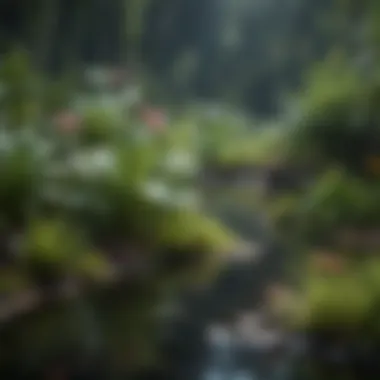
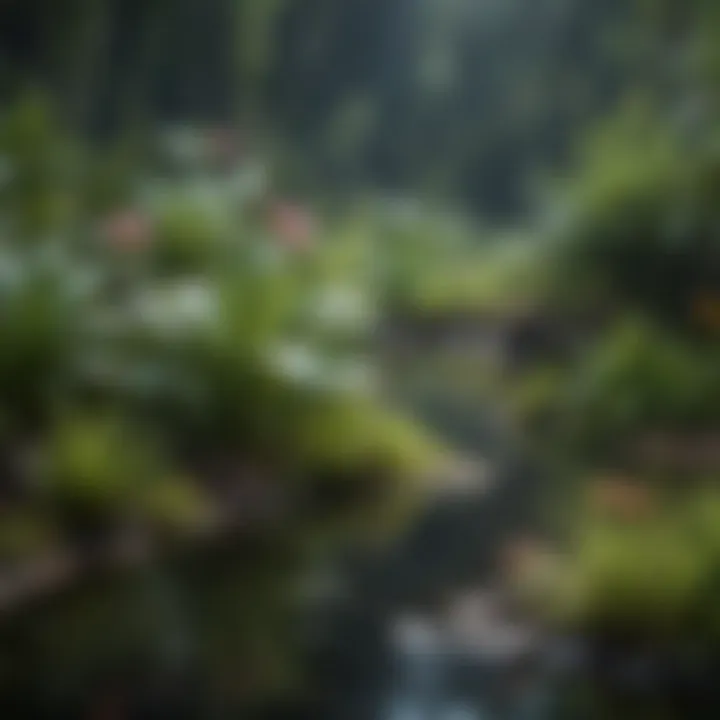
Encouraging the presence of beneficial microorganisms through proper maintenance will support healthier fish as well.
Maintenance and Upkeep of the Pond
Maintaining a pond isn’t just about keeping it pretty; it’s a fundamental aspect of supporting a thriving ecosystem. Regular upkeep fosters a healthy environment for aquatic life, prevents common problems, and enhances the overall aesthetic appeal of your water feature. Like any garden, a pond requires thoughtful attention, and neglect can lead to challenges that affect both water quality and biodiversity.
Routine Maintenance Practices
Establishing a maintenance routine is essential. Regular checks ensure that all elements of the pond's ecosystem are functioning as intended. Here are some key practices:
- Inspect Water Levels: Take a gander at the water levels, especially during dry spells. Adjustments may be necessary if levels drop significantly.
- Check Filters and Pumps: Keep those filters and pumps clean and operational. It’s a chore, sure, but a dirty or malfunctioning system can lead to murky waters.
- Remove Fallen Leaves and Debris: Autumn leaves are beautiful, but they can clog up filters and decompose, leading to poor water quality. Regular skimming keeps things tidy.
- Test Water Quality: Testing kits can make a world of difference in detecting issues like pH imbalance or high nutrient levels. The earlier you spot a problem, the easier it is to correct it.
- Observe Wildlife: Keep an eye on the wildlife your pond attracts. A sudden drop in fish or the absence of frogs can indicate underlying issues.
Addressing Algal Blooms and Debris
Algal blooms can rear their ugly heads if nutrient levels become too high, often due to run-off or excess organic matter. It’s a natural process, but a problematic one. Here’s how to tackle it:
- Reduce Nutrients: Check for sources of excess nutrients such as fertilizers from nearby plants. A little less can have a big impact.
- Introduce Natural Predators: Consider adding fish like goldfish or tilapia, known for munching on algae. It’s Mother Nature’s way of keeping things balanced.
- Implement Aeration: Keep the water moving with aerators. Stagnant water is a breeding ground for algae and other unhealthy bacteria.
"It's much easier to manage a pond than to fight a major outbreak of algae; proactive measures lead to better outcomes."
Seasonal Adjustments and Preparations
Each season brings a unique set of challenges and opportunities for pond maintenance. Preparing in advance for seasonal shifts can save a world of headaches:
- Spring Preparation: As the frost fades, check for winter damage.Remove any debris that has accumulated and ensure that aquatic plants begin thriving again.
- Summer Care: During hot months, monitor water temperature and consider shade plants to cool the water naturally. Be vigilant about algae growth.
- Autumn Tasks: Trim back any overgrown vegetation and clean out fallen leaves. It's a tedious bit of work, but it lays the groundwork for a healthy winter.
- Winter Strategies: If living in a cold climate, you might need to de-ice portions of the pond for fish. Consider the placement of heaters or aerators to ensure your aquatic friends have enough oxygen.
Keeping up with these practices ensures that your pond doesn’t just survive but thrives. An ongoing commitment to maintenance, informed by seasonal changes and proactive measures, creates a sanctuary for both people and wildlife.
Building a Natural Habitat
Creating a pond is not just about filling a hole with water; it’s about fostering a mini-ecosystem that can thrive and sustain various life forms. Building a natural habitat within your pond ensures that the environment is balanced and serves multiple forms of wildlife. The inclusion of natural structures and native plants isn’t merely decorative; they provide ecological benefits that can greatly influence the health of the pond.
A well-planned habitat presents numerous advantages. Firstly, it plays a crucial role in supporting biodiversity. When you incorporate features that mimic a natural environment, you create spaces for different species to thrive. This can bolster everything from aquatic plants to fish and insects, which in turn can enhance the overall aquatic ecosystem. Additionally, a rich habitat provides natural filtration, improves water quality, and can even assist in controlling algae blooms.
Considering various factors while building a natural habitat can lead to more effective results. For instance, incorporating rocks, logs, or submerged vegetation not only adds beauty but also provides shelter and breeding grounds for various species. It’s essential to take into account the local flora and fauna, ensuring that the pond complements the surrounding environment.
"A diverse habitat supports a delicate balance and fosters a thriving ecosystem."
Incorporating Natural Structures
Natural structures such as rocks, logs, and vegetation are paramount to achieving a functional pond environment. Not only do these elements enhance the aesthetic appeal of the pond, but they also serve practical roles in habitat creation. For example, adding submerged logs can provide hiding spots for fish and invertebrates, which can help maintain a balanced food chain.
Additionally, rocks can act as nesting sites for amphibians. The different sizes and shapes of these structures also vary the water depths, which can be especially beneficial for certain aquatic plants and animals.
When planning your pond, think about:
- Placement: Strategically placing structures can create a more dynamic environment.
- Material Types: Use natural materials that blend into the landscape, promoting a seamless transition between the pond and surrounding areas.
- Variety: A mix of structures enhances biodiversity, attracting different species.
Supporting Wildlife Interactions
The more diverse the pond, the more interactions you’ll see among various wildlife species. When you design your pond to support wildlife, consider how many species of plants and animals can coexist. Native plants, like cattails and water lilies, can attract beneficial birds and insects, creating a lively atmosphere.
Fish, frogs, and dragonflies are just a few of the creatures that benefit from a well-planned habitat. Encouraging these interactions can also help in pest control, as natural predators maintain population numbers in the ecosystem.
Think about setting up food sources like wildflowers near your pond, which can attract pollinators. You might also consider installing bird feeders or bat houses nearby to further increase wildlife interactions.
Encouraging Beneficial Insects
Insects are often overlooked in pond planning, yet they play a crucial role in the ecosystem. By providing habitats, you encourage beneficial insects like dragonflies, damselflies, and various aquatic beetles that can improve pond health. These insects act as both pollinators and predators, targeting pests that could harm your aquatic plants or fish.
To attract beneficial insects:
- Plant native wildflowers around the pond's edge to provide food and shelter.
- Create shallow areas where insects can breed and find refuge.
- Avoid using chemical pesticides, which can harm beneficial insect populations.
Carefully considering these elements while building your pond will lead to a vibrant aquatic habitat that supports a diverse range of wildlife, making your pond an integral part of the local ecosystem.
Navigating Legal and Environmental Regulations
Setting up a pond is not just about digging a hole and letting it fill with water. It's a whole process, laden with responsibilities that tie to the law and environmental conservation. The realm of legal and environmental regulations can seem daunting, however, understanding these elements is crucial for nurturing a pond that not only thrives but also respects local ecosystems and community guidelines. Without adhering to these regulations, one could face hefty fines or, worse, harm the very environment they wish to improve.
Understanding Local Regulations
Before plunging into your pond project, it’s essential to understand the local laws that govern water bodies. Different regions have varying regulations regarding water use, wildlife protection, and land management. Each locality's rules aim to preserve natural habitats, ensuring that the creation of artificial ponds doesn't disrupt the existing ecology.
- Permitting: You might require permits before even breaking ground. Often, these permits assess how your pond will affect local wildlife and water quality. Checking with local government offices can provide clarity on required forms and fees.
- Water Use Rights: It may come as a surprise, but you don’t automatically have the right to use water from streams or rivers. Depending on your area, you might need water rights before diverting any water.
- Wildlife Protections: Regulatory bodies may implement protections for certain species that reside in the proposed pond area. This can include endangered species or migratory birds. Knowing these can save you legal problems down the road.
Environmental Impact Assessments
An Environmental Impact Assessment (EIA) is a systematic process to evaluate the potential environmental effects of a proposed project, like your pond. It’s not merely a formality; it is an essential part of responsible pond management. Evaluating impacts helps foresee issues before they arise and determines necessary actions to mitigate negative consequences.
Several aspects are analyzed during an EIA:
- Water Quality: Establishing a pond can change local water quality. Assessments will look at potential contaminants and methods of water filtration that align with environmental standards.
- Ecosystem Interaction: How will the pond affect existing species? An EIA explores the relationships between local flora and fauna and gauges the effects of introducing new species, such as fish or aquatic plants.
- Mitigation Plans: Aside from pinpointing negative impacts, an EIA will often outline a plan to lessen these harms, whether it’s through fencing to protect sensitive habitats or monitoring fish health.
Best Practices for Compliance
Sticking to regulations can feel like a tough nut to crack, but following best practices offers a path to smooth sailing.
- Research Thoroughly: Familiarize yourself with both local and broader environmental regulations, including those from state or federal levels, if needed.
- Consult Experts: You might want to reach out to environmental consultants or local extension offices. They can provide guidance specific to your geographic area.
- Adaptive Management: Regulations can evolve, and staying adaptable is key. Be ready to shift approaches based on changing laws or new environmental science insights.
- Community Engagement: Involving local communities in planning can not only enhance compliance with regulations but also foster goodwill. Communities often have a stake in local ecosystems, and their input can lead to better management practices.
"In the realm of nature, every action has its echo. This is especially true when constructing a pond—a slight misstep could ripple through local ecosystems."
By comprehensively navigating legal and environmental regulations, you lay the groundwork for a healthy pond that positively integrates with the surrounding ecosystem. Compliance isn't merely a checkbox; it's part and parcel of creating a sustainable aquatic environment.
Pond Challenges and Solutions
Setting up a pond is not just about digging a hole and filling it with water; it's a holistic approach that encompasses various challenges that arise over time. Addressing these challenges is crucial to ensure the sustainability and health of your aquatic environment. In this section, we will delve into common pond challenges and offer practical solutions, emphasizing the importance of proactive management.
Dealing with Water Level Fluctuations
Water level variations can be a headache for many pond owners. Rain, evaporation, and seasonal shifts can all impact the stability of water levels. If the water dips too low, it can stress aquatic life; if it rises too high, it can lead to flooding and erosion.
One way to manage water levels is through effective catchment design. Consider installing a retention basin that allows for controlled overflow during heavy rains. Regularly monitoring rainfall can also help you anticipate water level changes. Additionally, implementing a rainwater collection system can mitigate drastic fluctuations and provide a consistent supply during dry spells.
Another consideration is ensuring proper vegetation around the pond, as plants can effectively stabilize the soil and reduce evaporation. This “buffer zone” not only serves a functional purpose but also enhances the aesthetic of the area, creating a more inviting environment. If water scarcity is a constant concern, exploring drought-resistant plants may help sustain the ecosystem without needing excessive resources.
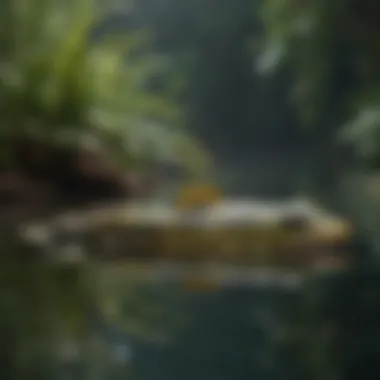

Managing Erosion and Sedimentation
Erosion can wreak havoc on a pond’s integrity. It can lead to sediment accumulation that clouds water and disrupts aquatic habitats. The effectiveness of a pond can deteriorate quickly if silt builds up or the banks wash away.
To combat erosion, it’s essential to establish vegetative barriers around the pond, using native plants that have strong root systems. Their roots hold the soil together while also filtering water and providing habitats for various organisms. Utilizing geotextile fabrics in high-risk areas can also be beneficial; they help to stabilize soil while allowing water to pass through.
Moreover, regular maintenance, such as clearing debris and managing runoff, can significantly ameliorate erosion issues. Consider creating natural barriers using rocks or driftwood to redirect water flow and protect vulnerable areas. Being proactive can save much hassle down the road and keep your pond thriving.
Combatting Invasive Species
Invasive species can be likened to uninvited guests at a house party; they disrupt the balance and often outcompete native species for resources. Ponds may attract unwanted plants or animals that can alter the ecosystem drastically. Effective management is key in reducing their impact.
Regularly monitoring your pond is imperative. Keeping an eye out for common invaders like cattails or water hyacinth helps you identify problems before they escalate. If you spot them, act quickly—remove them promptly to limit their spread.
Education is equally important. Engaging with local conservation groups or online communities can provide insights into preventative measures that others have found effective. Additionally, using native species for planting can be a smart way to bolster the local ecosystem against invasive threats. Native plants thrive in local conditions and can help restore the balance that invasives disrupt.
By actively addressing these challenges, pond owners not only protect their investment but also promote healthier ecosystems. As the saying goes, "an ounce of prevention is worth a pound of cure." Utilizing thoughtful practices in dealing with water level fluctuations, managing erosion, and combatting invasive species creates a resilient pond environment. Every little effort counts!
Community Involvement and Education
Community involvement and education play a crucial role when it comes to setting up and maintaining a pond. These factors not only ensure the sustainability of the aquatic ecosystem but also foster a sense of ownership and responsibility among local residents. It is imperative to recognize that a pond is not merely a personal project; it can become a vital resource for the entire community. Engaging community members enriches the ecological diversity of the pond through shared knowledge and varied perspectives, ultimately leading to a richer habitat.
Engaging Local Communities
Getting local communities involved is about more than just enlisting help; it's a way to create a thriving ecosystem that reflects the interests and needs of the people surrounding it. Here are some ways to engage them effectively:
- Community Meetings: Holding regular meetings to discuss pond plans can allow residents to voice their opinions and suggestions. These forums cultivate a sense of belonging and empower the community to contribute.
- Volunteer Days: Organizing events where community members come together to help clean, plant, or maintain the pond creates a shared bond and instills pride in the project.
- Collaborative Projects: Working with local schools or organizations can expand participation. For instance, a science class might study the pond's ecosystem, thereby intertwining education with active participation.
Engaging local communities ensures that the pond becomes a communal asset, serving not just ecological functions but also social ones.
Creating Educational Programs
Education goes hand in hand with involvement. To maximize the pond’s potential, educational programs can be developed that shed light on various facets of pond ecosystems:
- Workshops and Seminars: Offer sessions focused on topics like aquatic biodiversity, sustainable practices, or water quality management. This knowledge not only empowers individuals but fosters a community-wide appreciation for the ecosystem.
- Hands-on Learning: Set up field trips where school children can experience the pond first-hand. Practical experiences reinforce theoretical knowledge and inspire younger generations to value and protect local environments.
- Online Resources: Provide websites or social media channels where community members can access information about pond care, maintenance, and biodiversity. This digital approach broadens reach and keeps engagement ongoing.
Creating educational programs helps demystify ecological concepts, making them accessible and relevant to everyday life.
Promoting Conservation Awareness
Raising conservation awareness is vital for ensuring the long-term sustainability of ponds and their surrounding habitats. To effectively promote it:
- Local Campaigns: Initiating conservation campaigns can bring together efforts for cleaner, healthier ponds. By highlighting the importance of water quality and biodiversity, community awareness can soar.
- Involving Local Media: Partner with local newspapers or radio stations to share success stories, educational tips, or events. Communication is key to reaching an audience that might otherwise remain uninformed.
- Social Media Engagement: Utilize platforms like Facebook or Reddit to keep discussions active. Regular posts about the pond, its health, and ongoing projects can spark interest and informed action.
Promoting conservation awareness in the community fosters a culture of responsibility and stewardship, vital for supporting sustainable practices.
"A thriving pond is not just a personal oasis; it is a community treasure that reflects care, commitment, and collaboration."
Through these efforts, the community will not only benefit from the recreational and ecological advantages of the pond, but will also nurture a deeper connection to nature. This engagement, education, and awareness create a lasting relationship between locals and their environment.
Case Studies of Successful Ponds
Examining successful case studies of ponds can provide great insights into effective management practices and essential considerations for those looking to establish their own aquatic environments. These real-world examples exhibit not only the triumphs but also the challenges faced in creating vibrant pond ecosystems. Learning about these instances encourages a practical approach toward nurturing ponds, imparting valuable lessons that can guide both novice and experienced pond creators.
Notable Examples and Their Management
One standout example comes from the Lady Bird Johnson Wildflower Center in Austin, Texas. This center has implemented various ponds that do not just serve aesthetic functions but also play vital roles in supporting local wildlife and plant species. The management of these ponds is characterized by using native flora that thrives in the local environment, reducing maintenance requirements and avoiding the introduction of invasive species.
In contrast, the Central Park Pond in New York City has seen various management strategies aimed at balancing recreational use with environmental preservation. The integration of benches and walking paths encourages community engagement while careful monitoring of water quality ensures that the ecosystem remains healthy. Water lilies are introduced every spring to provide habitat for fish and shade, creating a balance that benefits both people and nature.
Lessons Learned from Established Projects
From these instances, several lessons can be extracted.
- Native Plants Matter: Utilizing local plant species tends to yield better ecological results. They’re adapted to the climate and soil, helping the pond flourish with minimal intervention.
- Water Quality Monitoring is Key: Regular assessments of the water quality can preemptively address issues before they become detrimental. This includes checking nutrient levels, pH, and clarity.
- Community Involvement is Valuable: Engaging local communities fosters a sense of ownership, which can lead to better maintenance and care of the ponds. Encouraging educational programs about the local ecosystem enhances public understanding and appreciation.
Overall, the stories of these ponds remind us that management should be adaptive and thoughtful, responding to both ecological needs and community interests.
Innovative Approaches and Techniques
Several ponds stand out not just for their beauty, but for innovative techniques employed in their development and management.
For example, the Greendale Pond in Oregon employs sustainable drainage systems that help control stormwater runoff. These systems not only keep the water clean but also enhance biodiversity by providing habitats for a variety of species. Furthermore, the use of bioengineering techniques for embankments reduces erosion while maintaining a natural look.
Another noteworthy approach is the use of aeration systems in the Elmwood Pond in Illinois. Here, an oxygenation system has been integrated to ensure a well-oxygenated environment for fish and plants alike. This type of technology addresses the problems of stagnation and algae blooms common in many ponds.
A critical takeaway from these innovative setups is that modern technology, when employed wisely, can significantly enhance traditional pond management practices. Efforts to adapt creatively to ecological challenges pave the way for ponds that are not only sustainable but also resilient.
"Through examining successful pond case studies, one uncovers a wealth of experience and knowledge that can illuminate the path for aspiring pond builders."
The Future of Pond Ecosystems
The future of pond ecosystems is an increasingly crucial topic as humanity grapples with environmental challenges. Ponds serve as more than just tranquil backyard features; they are essential habitats that promote biodiversity, contribute to water management, and manage the overall health of the environment. Understanding the evolving dynamics of these ecosystems is key to ensuring their sustainability and resilience.
As we move forward, it becomes vital to acknowledge that the management of ponds will need to adapt to contemporary issues. Active engagement from all stakeholders is paramount— from local communities to scholars and environmentalists— to foster the collective stewardship of these resources.
Trends in Pond Management
Pond management trends are continuously shifting, inspired largely by scientific advancements and socio-environmental developments. Some noteworthy trends include:
- Holistic Management Strategies: There's a growing recognition that ponds should not be viewed in isolation but as part of broader ecosystems. Integrating pond management with land use planning, agriculture, and urban development is becoming essential.
- Sustainable Practices: More caretakers are leaning towards organic methods, reducing chemical use, and promoting natural controls to manage pests and algae.
- Community Involvement: Increasingly, local citizens are encouraged to participate in the management process, ensuring that the pond's health reflects the community's values and needs.
Keeping abreast of these trends will allow pond enthusiasts to make informed decisions that preserve and enrich these ecosystems.
Impacts of Climate Change on Ponds
Climate change poses significant challenges to pond ecosystems, leading to dire consequences that can ripple through the environment. Changes in temperature, precipitation patterns, and the frequency of extreme weather events can drastically alter the landscape.
Key impacts include:
- Temperature Fluctuations: Warmer waters can disrupt aquatic life cycles, affecting fish breeding, plant growth, and the overall ecological balance.
- Increased Runoff: More intense storms lead to greater runoff and sedimentation, resulting in poorer water quality and altered habitats.
- Invasive Species Proliferation: Warmer conditions might favor non-native species over indigenous plants and animals, leading to a decline in biodiversity.
The long-term future of pond ecosystems hinges on our understanding and adaptation to these climatic shifts.
Innovative Solutions for Sustainability
Sustainability is key to the longevity of pond ecosystems. Innovative solutions are emerging to address the pressing challenges posed by climate change, pollution, and habitat degradation. Some promising strategies include:
- Artificial Intelligence and Data Analytics: By utilizing AI, we can monitor water quality in real-time, predict algal blooms, and optimize the growth conditions for both plants and fish.
- Bioremediation Techniques: Harnessing natural processes can remediate polluted water through specially selected plants and microorganisms, offering a cost-effective way to improve water quality.
- Community Educational Initiatives: Engaging and educating the public about the health of their local pond fosters a sense of ownership and encourages sustainable practices.
Efforts in these areas can help ensure that ponds remain vibrant ecosystems that contribute positively to the environment and the communities that surround them.



